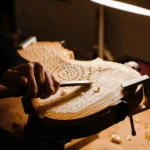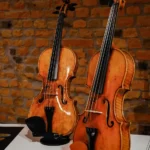Redefining Soundscapes: The Amorim’s Model X Cello Bridge
Back to BlogRedefining Soundscapes: How Amorim’s Model X and Finite Element Method are Transforming Cello Sound Production
The cello is a beautiful, complex instrument known for its rich, deep sound. The bridge of the cello is an essential component of its structure, responsible for transferring the strings’ vibrational energy into the body and contributing significantly to the instrument’s overall sound. To achieve the best possible sound, the cello bridge needs to be light enough to efficiently transmit the strings’ movement yet rigid enough to support the static load of the strings.
Throughout history, there have been many attempts at designing the ideal cello bridge. Over time, luthiers have arrived at two standard models: the French and the Belgian. These designs have been refined over the years, but the basic principles remain unchanged. However, in recent years, the Amorim family of luthiers in Cremona, Italy, has developed a new cello bridge design, which has garnered much attention in the music world.
Figure 1. (a) Picture of a French model cello bridge blank (courtesy of luthier Matteo Pontiggia). (b) Picture of Amorim’s Model X blank during the final construction stages (courtesy of luthier Luiz Amorim). (c) Three examples of our 3D model and its evolution as we vary the control parameter of the legs.
Amorim’s Cello Bridge x Finite Element Method
Inspired by Amorim’s fifth-generation cello bridge called the X-model, the team at the Musical Acoustic Lab of the Politecnico di Milano has conducted a study to investigate the influence of the shape of the legs of the cello bridge on its static and vibrational behavior. They used parametric modeling and simulations using the Finite Element Method to study different geometries of the bridge legs. They performed displacement and modal analysis for different boundary conditions, providing a detailed description of the mode shapes. The full study was recently published in the journal Applied Science in a special issue dedicated to musical instrument mechanics, dynamics, and acoustics.
The simulations showed that changing the shape of the bridge legs resulted in a change in the apparent stiffness of the bridge. Specifically, they found that the variation in apparent stiffness has a linear dependence on the parameter controlling the shape variation of the legs.
Figure 2. Displacement fields on the bridge under load. (a) The magnitude of the displacement along the x direction. (b) Displacement along the y direction. (c) The spatial average of the displacement along the x direction is normalized for the Normal Model as a function of the model number. (d) The spatial average of the displacement along the y direction is normalized for the Normal Model as a function of the model number. The R-squared refers to the first portion of the fit, as the constant value in the second portion is the mean.
Stiffening Cello Bridges with Design
The range of stiffness values reachable with this varying geometry corresponds to a 50% increase in longitudinal stiffness and a 17% increase in radial stiffness when it varies between the traditional Belgian and the X-model. This suggests that the shape of the bridge legs can be used to control the cello’s vibrational and static responses and tune its sound. In particular, thanks to the increase in the apparent stiffness of the bridge, the bridge can be made lighter, helping with the energy transmission from the strings to the corpus of the instrument.
They also computed and compared frequency response functions for the different geometries. The results showed that the response in the mid-range can be continuously controlled by changing the geometric parameter. This would allow the instrument maker to fine-tune the response of an instrument in a particular frequency range without having to make structural changes to the instrument, only to the setup.
However, an aspect they have not studied in this article is the influence on sound and playability due to design variations. They acknowledge that changing the shape of the bridge will shift the position of the modes in the so-called “bridge hill” region, so a change in the mid-range components of the sound is expected. According to the musicians who tried Amorim’s model, the cello responds faster and is “easier” to play. This points towards a change in the minimum bow force due to the change in bridge resonances. Accurately studying the force needed to play an instrument is an exciting open area of research, and other groups worldwide (in particular in Vienna and Paris) are developing the scientific methodologies needed to achieve this.
Amorim’s Model-X Bridge
Amorim Fine Violins has developed a unique cello bridge model called Model X, designed by the company’s founder, Luiz Amorim. The Model X’s distinctive shape facilitates direct sound production and faster response, resulting in a more powerful, focused, crystal-clear sound. The goal was to create a bridge to establish a direct connection between the strings and the top without a lengthy transmission path.
Luthiers like Luiz Amorim are never-ending seeking better sound quality. With years of experience crafting fine cellos, Amorim has always wanted to push the boundaries of instrument-making and explore new ways to enhance the sound of his creations. One result of his tireless pursuit of excellence is the Amorim bridge, also known as Model X.
The unique shape of the Model X is the key to its superior sound quality. As Amorim explains, the bridge is an essential component for sound emission in a cello, and by improving and changing it, the instrument’s characteristics can be altered. Traditional cello bridges have a longer transmission path for sound, with many excess materials, such as the long decorative arms. In contrast, the Model X features a shorter, more direct transmission path with less useless material. This shorter path allows for a quicker response and a more focused, crystal-clear sound.
The Evolution of The Models
The development of Model X was a process that involved experimentation, observation, and modification. Amorim and his partners made cello setups every day, and through this daily practice, they discovered that different bridge models brought different results. This led to the idea of creating a bridge entirely different from anything on the market and had better results.
The journey towards the Model X began in 2016 when a customer shared an American research article with Amorim that suggested an x-shaped format for the best result with different bridge formats for violoncello. This starting point gave Amorim and his team the inspiration they needed to experiment with the x-shaped format. The first Model X was not fully X-shaped, but it was less curved than traditional models, and it already showed some improvement in sound quality.
Amorim Bridge Model X, First Model
Following the first pre-model, Amorim experimented with two half-moon cuts instead of a heart-shaped cut to achieve a more direct transmission. Although the central strings benefited from this change, they found that excess material was still present.
Amorim Bridge Model X, Second Model
In the second model, they focused on reducing material at the waist and creating more dynamic movement in the central region. They brought back the central heart, which improved the brightness of the sound but caused a slight loss of quality in the central strings.
Amorim Bridge Model X, Third Model
The third model featured shortened arms and a reduced central mass. They experimented by digging out the legs internally to create a concavity and decrease material in that region. This resulted in much better quality and power in the sound transmission while still maintaining speed.
Amorim Bridge Model X, Fourth Model
Continuing to refine the design, the fourth model further shortened the arms and increased the size of the heart while reducing the width of the upper region. This produced an even better result with a more pronounced difference in sound quality compared to the previous models.
Amorim Bridge Model X, Fifth Model
The fifth and current model features an increased arch in x and height while maintaining shortened arms at the same height. The back and front parts of the legs gained an inclination, where the inner part of the feet was thicker than the outer part, creating a decrease in mass without compromising resistance. This has led to a significant improvement in sound quality, which is fully satisfactory. The Amorim team has consistently experimented with various details to achieve optimal material reduction and sound quality balance in each model iteration.
The Amorim Fine Violins Bridge Model X has been used in many cellos, and the difference in sound quality compared to traditional models is significant. Customers experimenting with the Model X have reported that their instruments have more focus, power, and crystal-clear sound. The Model X is a testament to Amorim’s commitment to always searching for ways to improve instruments and his dedication to the craft of luthiery.
In conclusion, studying the influence of the shape of the legs of the cello bridge on its static and vibrational behavior is an exciting development in the world of luthiery. The research provides valuable insights into how the shape of the bridge can be used to tune the sound of the cello and highlights the potential of computational modeling and simulation in studying complex systems. The study is an excellent example of the intersection between science and art. It demonstrates how advances in one field can profoundly impact another when they are willing to work together.
Gaian Amorim and Sebastian Gonzalez conducted the research, which was published in the Applied Science journal. The article revealed the impact of cello bridge leg shapes on static and vibrational behavior. This article was also published in the April 2024 edition of Strad Magazine.









